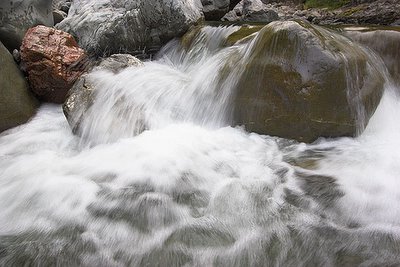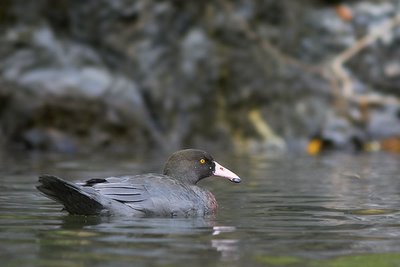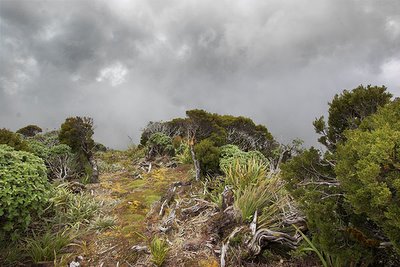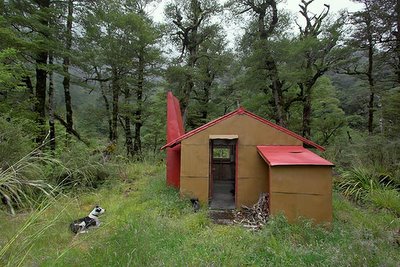Murray had been killed in a cycle race in Hawkes Bay. I couldn’t believe it; even now I have moments of disbelief.  I hesitated, wondering whether to call Nobby and postpone the whio [1] survey, but the notice was as short as it could have been: I was about to drive to the field station to meet him and head for mid Pohangina hut. We’d already postponed it from the week before Christmas, and leaving it another week wasn’t ideal. He’d probably have to find someone else at short notice—no notice, in fact. Yet, that seemed unimportant compared with the need to be with friends and colleagues.
I hesitated, wondering whether to call Nobby and postpone the whio [1] survey, but the notice was as short as it could have been: I was about to drive to the field station to meet him and head for mid Pohangina hut. We’d already postponed it from the week before Christmas, and leaving it another week wasn’t ideal. He’d probably have to find someone else at short notice—no notice, in fact. Yet, that seemed unimportant compared with the need to be with friends and colleagues.
I wondered what Murray would’ve wanted, and the answer seemed very clear. I could imagine him looking at me with that slightly sly smile, head tilted back a little, then very deliberately telling me to go out there and enjoy the environment that means so much to me; go out there and do a good job. I know he’d have trusted me to do the job well. And I’m pretty sure he’d have told me to enjoy the beer when the trip was over and have a few in his memory as well. It all seemed plausible, but it all seemed like a convenient rationalisation.
The last thing she said was, “You take care up there, won’t you”.
It’s what happens when we lose a friend—suddenly everyone we’re close to becomes especially important; we want to look after them, protect them. The thought of losing another friend is too much to bear.
...
I drove to the field centre as the knowledge of Murray’s death began to sink in. That tight feeling, a cramp in the throat; remembering those Murray moments, like the time he emailed everyone asking if anyone had seen his spectacles only to discover they were perched on his head... or the time he stopped in the doorway of my office, talked for ages, got halfway down the corridor then returned to talk for another 20 minutes because he’d remembered something else. Then he did it again. I couldn’t believe I’d never again enjoy times like that—I didn’t want to believe it.
We made good time to mid Pohangina hut and relaxed while we waited for evening, when the whio would become active. Bro curled up in the long grass by the verandah and dozed in the sun while Nobby stretched out on one of the bunks and read and explored the map. I made my way through tall, rustling grass to the river and sat on a sun-warmed boulder, listening to the rush of water, watching the breeze tremble toetoe heads. A big dragonfly [2] rattled past; afternoon sunlight glittered on the big pool. I realised that two things are—and probably always will be—incomprehensible to me. Being born, and dying.
That evening, Nobby and Bro climbed over the spur behind the hut to drop into Cattle Creek while I waded and boulder-hopped downstream, below the swingbridge, past the Cattle Creek junction and partway into the gorge. I saw no ducks on the way down, but on returning, heard a whistle from the river just downstream from the junction. A lone, male whio, clearly agitated, swam and whistled in the pool where the river turns sharply. Eight o’clock in the evening. The bird climbed out of the water onto a rock and through binoculars I could see it had no bands. It dropped back into the pool and I managed one blurry photo in the dim light before it took to the wing and flew upstream, out of sight. I followed it, past the hut and on to where the river split into two channels, but I never saw it again. Nobby and Bro saw no sign of whio up Cattle Creek.
...
Early the next morning we searched downstream to the gorge but saw nothing other than an occasional whio shit—desiccated, disintegrating, sandy with the homes of digested caddis larvae. Of the whio I’d seen the previous night, there was no sign. Back at the hut we packed and left for Ngamoko; the warmth of the day just becoming noticeable, replacing last night’s cold. Despite the overnight chill the river wasn’t cold; crossings were easy and seldom above the knee. The morning sun lit rapids, pools, boulders, the edges of trees, and I remembered the time I’d walked from Leon Kinvig hut to Ngamoko and thought the Pohangina to be one of the most beautiful rivers I know. That thought returned as we boulder-hopped and waded upriver. I looked around, remembered Murray; how he’s no longer here to delight in this sort of experience. The sun rises, fills the world with joy, but it’s a changed world. What Raewyn had told me didn’t seem possible.
I thought of Murray’s family and all his—and my—friends at the Landcare Research site [3]. Had I made the right choice? Was it really what Murray would’ve wanted?
Years ago I’d seen and photographed whio in several locations along the Pohangina, but when we reached Ngamoko hut we’d still seen none. Just some feathers in a little cave under jumbled boulders by the water, and some very fresh shit, not yet dried out, still moist and coherent—probably less than a day old.
 Two o’clock and the sun’s brilliant in a cloudless blue sky but the strong gusty wind’s cold. Bro keeps shifting from sun to shade and back again. I’ve split a couple of big, tough rounds of saturated contorta and spread the blocks in the sun—something useful. A little mouse runs out from the long grass towards the hut, stops, looks at me, and runs back. A small, quivering, sleek-furred life with shining black eyes like beads. Or: vermin.
Two o’clock and the sun’s brilliant in a cloudless blue sky but the strong gusty wind’s cold. Bro keeps shifting from sun to shade and back again. I’ve split a couple of big, tough rounds of saturated contorta and spread the blocks in the sun—something useful. A little mouse runs out from the long grass towards the hut, stops, looks at me, and runs back. A small, quivering, sleek-furred life with shining black eyes like beads. Or: vermin.
We split up again in the evening. I checked upstream; Nobby and Bro climbed the track, dropped into the downstream sidecreek and came back upriver. They saw three whio and Nobby managed a few photos on his powershot—much better than the fuzzy image I’d snapped the previous evening. I walked upstream for a couple of hours, slowly, slightly uneasy at the apparent absence of duck shit—just a single, old streak of it. I stopped and took a few photos but felt uninspired. Cloud had begun to build; the sun came and went; and I wondered what the next day would bring. By the time I started back downriver the sky had turned to a grey overcast; by the time I was 20 minutes from the hut, misty cloud had settled low on the the ridges and spurs and a cold, strong wind knifed through both layers of clothing and chilled me. I was glad to get back, just ahead of Nobby and Bro.
...
The weather the next day, while lacking sun, was good for tramping—overcast, an intermittent wind, cool, but not uncomfortably cold. We left Ngamoko at 7:45 and made good time up the river, confirming what I’d seen the evening before—nothing.  But, a short distance upstream from the small gorge, Nobby saw a lone whio fly upriver. We moved on cautiously, hoping to see it before it saw us, but the next sighting was when I glimpsed it flying further up the river. We came upon it again, but this time it was swimming in a large pool where the river turned. I dropped my pack and poles, handed my binoculars to Nobby and crept forward while Nobby stayed behind where the bird could see him. I took a few photos as I edged closer, then slowly moved into full view, angling across the river to a small beach. The bird seemed cautious, but happy to continue drifting and bobbing in the pool. At the gravel beach, I lay down and took many careful photos but the dull light wasn’t flattering and the shutter speeds marginal. I think I’d most enjoyed simply watching the bird through the telephoto—the golden eye, the bright, pinkish-white bill, the texture and colours of feathers, silvery beads of water... taking the photos seemed incidental. Of course, after I’d slowly retreated and walked back to where Nobby was waiting, the sun almost broke through.
But, a short distance upstream from the small gorge, Nobby saw a lone whio fly upriver. We moved on cautiously, hoping to see it before it saw us, but the next sighting was when I glimpsed it flying further up the river. We came upon it again, but this time it was swimming in a large pool where the river turned. I dropped my pack and poles, handed my binoculars to Nobby and crept forward while Nobby stayed behind where the bird could see him. I took a few photos as I edged closer, then slowly moved into full view, angling across the river to a small beach. The bird seemed cautious, but happy to continue drifting and bobbing in the pool. At the gravel beach, I lay down and took many careful photos but the dull light wasn’t flattering and the shutter speeds marginal. I think I’d most enjoyed simply watching the bird through the telephoto—the golden eye, the bright, pinkish-white bill, the texture and colours of feathers, silvery beads of water... taking the photos seemed incidental. Of course, after I’d slowly retreated and walked back to where Nobby was waiting, the sun almost broke through.
Last night Murray appeared in my dreams, as two people who looked identical to him but weren’t. I couldn’t explain this but as in all dreams I understood it perfectly. Seeing him, I couldn’t speak; a deep sadness enveloped me. I don’t know if I dreamed this or it was real.
From Leon Kinvig hut we walked a long way upstream in the evening, reaching a point not far from the top gorge. We’d walked slowly for an hour and a half and had seen no whio, no whio shit other than one, old streak. By then the river carried very little water, the skyline under its grey cloud seemed much lower; everything had the feel of a smaller-scale world. The skeletons of old, dead trees clawed up from low, mixed scrub and forest; dull yellow snowgrass and the long fronds of toetoe partly covered slips; rubble and logjams littered the riverbed. It looked like a good place for deer, but a strong wind blew at our backs, occasionally switching to send a gust downriver, making any sightings of deer improbable. Near our turnaround point the predominant direction reversed, now buffeting hard down the river with a few upriver gusts. Nobby and Bro checked a promising sidecreek for duck sign while I carried on to the hut; once, a tremendous blast of wind ripped down the valley, almost blowing me off my feet.  That night the weather finally decided to make up its mind. It decided to rain, and just for good measure to hurl occasional, violent gusts at the hut. The river rose, and by morning it was huge, dirty, frothing, and unquestionably uncrossable. To have set foot in it would have been suicidal. But, during the night, we heard a whio whistling opposite the hut. I imagine it was perfectly happy to bob about on the floodwaters, as impossible to drown as a cork.
That night the weather finally decided to make up its mind. It decided to rain, and just for good measure to hurl occasional, violent gusts at the hut. The river rose, and by morning it was huge, dirty, frothing, and unquestionably uncrossable. To have set foot in it would have been suicidal. But, during the night, we heard a whio whistling opposite the hut. I imagine it was perfectly happy to bob about on the floodwaters, as impossible to drown as a cork.
After an early lunch we cleaned, packed, and began the climb to the main Ruahine Range. The weather had partly cleared and we’d expected to suffer from the heat, but for much of the climb we were in shade under a canopy mostly comprising beech, kamahi, and kaikawaka [4]. At the summit, where the track forked, one way going to the eastern access, the other to Longview hut, we stopped while Nobby called the field centre and I took a few photos. Misty cloud swirled around the tops near Pohangina Saddle and hung over the foothills and valleys in the east; in the distance, we saw farmland; even further, in the haze on the edge of the world, a glimpse of the sea. The recently cleared track offered fast travel, but beyond the southern Makaretu hut junction, it reverted to an idiosyncratically graded, boggy, somewhat overgrown path; enough to slow us slightly until we reached the northern Makaretu junction and another recut section.
By then, the cloud had thickened and the overcast sky threatened weather the forecasters hadn’t predicted. We cruised on, coming to a slight saddle in the ridge,  where boggy ground supported a straggly cover of snowgrass, turpentine bush, and leatherwood. Something called from the low vegetation: a soft tchkk! tchkk! Nobby stopped; listened.
where boggy ground supported a straggly cover of snowgrass, turpentine bush, and leatherwood. Something called from the low vegetation: a soft tchkk! tchkk! Nobby stopped; listened.
“Fernbird,” he said [5].
We heard it calling, but couldn’t see it. Another bird started up on the other side of the track; a different, 2-note, bell-like call that puzzled both of us. I scanned the area with the Swarovskis. Nothing. Checking without the binoculars, I saw a bird fly over the low canopy and alight in a dead, gnarled leatherwood. I found it in the binoculars—about the size of a pipit, drab, strongly speckled underneath, a long, ragged tail. Fernbird. I’d seen them only once before, many years ago, and had always thought of them as associated with low-lying areas. The top of the Ruahine Range was the last place I’d have expected to see them.
A little further along the track, short of Rocky Knob, we dropped down to the river via a slip and a short section of straightforward bushbashing. By the time we’d reached Top Gorge hut we’d been walking for a little under 5 hours all up; soon afterwards, the rain began. But Top Gorge is a lovely little hut—just two bunks but with a spacious feel and two beautiful windows framing views of the beech forest—and sitting there yarning with Nobby, enjoying a brew, hearing the rain tapping on the tin roof, I thought again this might be what Murray would’ve wanted me to do: to relax and enjoy myself. When I caught up with friends after the survey, someone told me how so many people were doing things and saying, “It’s what Murray would’ve wanted.” I was just one of his huge circle of friends and colleagues, and many of those people knew him far better than I did—they would have known better what he would’ve wanted. But we’re all just guessing.
By morning the rain had stopped and a little blue sky appeared. We searched downstream as far as the point we’d reached the previous evening. Negotiating the gorge wasn’t much fun: a couple of nerve-wracking traverses across near-vertical, slimy, moss-encrusted rock walls with deep, oily water waiting below; a couple of bush-bashes, clinging to tenuous shrubs and fistfuls of toetoe or fragile fern fronds with a long fall underfoot... later, on the flats below the gorge, Nobby remarked that he wasn’t looking forward to going back up the gorge.
Yet again, we saw no whio. Any shit more than a few hours old would have been washed away by the rain, and we saw nothing fresh. Finally, where we turned back, I saw a small depression under a river’s edge boulder, and in it, what might have been a splatter of crap. I called Nobby over. He got down on his hands and knees and peered closely, then picked up a bedraggled feather. We looked at each other. He inspected further, and found two more, both pale with a faint slate-blue tinge, one with a hint of chestnut at the tip. It was the last sign of whio we saw on the trip.
The return through the gorge seemed much easier—fortunately. We walked the final, upper section of the river almost to Pohangina Saddle before climbing the short distance to the ridge and Longview Hut.  Not surprisingly, no one was there.
Not surprisingly, no one was there.
The trip’s drawing to a close, and I wonder when I’ll be back; when I’ll have another opportunity to work with Nobby and Bro again. They’ve been wonderful company. I shoulder my pack and set off after them, on the last section down to the car park at the end of Kashmir Road.
Duncan picks us up and drives for two hours, back to the Pohangina field centre, through the dry Hawkes Bay. Fields of ripe, yellow wheat ripple in the wind; grey sheep gnaw dusty, stubbled paddocks; the road shimmers with heat and cars. This is the Hawkes Bay. Somewhere over here, Murray, racing downhill, failed to take a corner and came off his bike. I don’t want to think about it. In those circumstances, people often say, “At least he died doing what he loved.” But for me that’s no consolation—he’s gone and I miss him. And for me it’s no consolation, because I’m sure it’s not what he would’ve wanted.
Notes:
1. New Zealand's endemic blue duck, Hymenolaimus malacorhynchos. Classified as nationally endangered.
2. Uropetala sp. (probably carovei).
3. Manaaki Whenua–Landcare Research, at Palmerston North.
4. Respectively, Nothofagus spp.; Weinmannia racemosa; Libocedrus bidwillii.
5. Bowdleria punctata; matata.
Photos 1 & 3: This is what we were looking for—whio. This is the bird (male) we saw about 20 minutes downstream from Leon Kinvig hut.
Photo 2: Pohangina river above Leon Kinvig hut, before the river flooded.
Photo 4: The eastern foothills of the Ruahine Range, from the main range above Leon Kinvig hut.
Photo 5: The recently cleared section of track along the main Ruahine Range between Leon Kinvig hut and Longview hut.
Photo 6: Top Gorge hut; upper Pohangina Valley
This is for Murray.
14 comments:
Wonderful. It's beautifully written and the photos are stunning, Pete.
It's lovely Pete. Thank you for sharing it (and Murray) with us.
I can only echo the others Pete, lovely photos and superb writing.
A beautiful tribute, Pete. I am sorry for your loss.
Hi Pete,
Like you, I've never found any consolation in someone dying "doing what they loved". I too want them here with me, so they can still do what they love to do, and still be here for me.
I imagine though, even though I do not know him, that Murray would heartily approve of your trek to search for whia. Life is so very fragile, and we should always seek to do things that we love while we live. And should death find us there, our friends can seek some solace in our passing, "doing what we loved".
Sorry that your friend has died.
Thankyou all; I really appreciate your thoughts. I've been catching up with friends here who knew and worked with Murray, and I realise how important it is to me — and, I suspect, to most people — to be able in these circumstances to reminisce and share what we feel. Murray was quite a character: the phrase "larger than life" can be used too freely, but not, I think, when describing him. Even now, after he's gone, he's still making new friends. Thanks again to all of you — it's good to know you know a little about Murray and what he means to us.
Thanks Wordgirl. It was a difficult one to write because I wanted something as true as I could manage. I think this gets close, but doesn't adequately convey how much fun it was being in that beautiful valley with Nobby and Bro. So much like life, I suppose: sadness and delight not just alternating, but often simultaneous. Maybe the next post will be a lot more spontaneous and loose...
Off down south for a few weeks' climbing next week. Hope to to catch up with you & the other fuelfools at some stage!
Others have already said so eloquently about this post, what I might have tried and failed. Such a beautiful tribute to a man who left his life and friends much too soon.
Thanks RD, I appreciate your thoughts.
lovely tribute and photos in honor of your friend and colleage- am glad I found your blog and will be back to visit again soon.
Here by the grace of Birdstock - I'm awed by the beauty of your words and photos: a heartfelt tribute to your friend. May we all have friends like you to cherish your memory of us.
Thanks Cindy and Soccer mom; I appreciate your thoughts. Apologies for the late response; I'm on the road, climbing and internet isn't a priority right now! I'll be back in a couple of weeks, with plenty to write about and show you. :^)
I'm sorry for you loss. We each get one lifetime, and that is it. But for those left, it is so much worse when it is a friend who is really living life well, and gone much too soon.
Thanks Zhoen. I know it's clichéd, but it's so true that life isn't a rehearsal. I think, too, that maybe it's worse when you lose a friend who has been struggling with life: there's the extra grief of knowing they missed out on so much joy. I'm so glad we were able to share so much laughter and joy with Murray.
Post a Comment